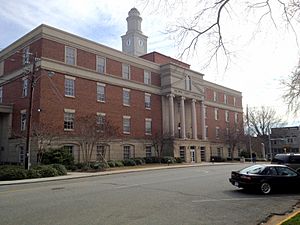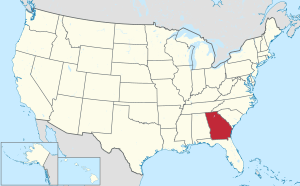Baldwin County, Georgia facts for kids
Quick facts for kids
Baldwin County
|
||
|---|---|---|

Baldwin County Courthouse
|
||
|
||

Location within the U.S. state of Georgia
|
||
 Georgia's location within the U.S. |
||
| Country | ||
| State | ||
| Founded | 1803 | |
| Named for | Abraham Baldwin | |
| Seat | Milledgeville | |
| Largest city | Milledgeville | |
| Area | ||
| • Total | 267 sq mi (690 km2) | |
| • Land | 258 sq mi (670 km2) | |
| • Water | 9.6 sq mi (25 km2) 3.6%% | |
| Population
(2020)
|
||
| • Total | 43,799 | |
| • Density | 170/sq mi (70/km2) | |
| Time zone | UTC−5 (Eastern) | |
| • Summer (DST) | UTC−4 (EDT) | |
| Congressional district | 8th | |
Baldwin County is a county in the middle part of Georgia, a state in the United States. In 2020, about 43,799 people lived here. The main city and county seat is Milledgeville. This city grew up along the Oconee River. Baldwin County is also part of the Milledgeville area, which is a smaller city region.
Contents
History of Baldwin County
For many centuries, the land that is now Baldwin County was home to the Creek Nation. Before them, different groups of indigenous peoples lived here for thousands of years.
How Baldwin County Was Formed
In 1802, the Creek people gave up some of their land in a deal called the Treaty of Fort Wilkinson. This land was then used to create Baldwin County. The state's law-making group, the Georgia General Assembly, officially created the county on May 11, 1803.
The land west of the Oconee River became Baldwin and Wilkinson Counties. Later, in 1805, another agreement with the Creek people, the Treaty of Washington, moved Georgia's western border further. More land was added to Baldwin and Wilkinson counties in 1806.
In 1807, the state legislature created four new counties from parts of Baldwin County. These new counties were Morgan, Jones, Putnam, and Jasper (which was first called Randolph County). Baldwin County also gained some land from Hancock and Washington Counties.
Who Baldwin County Is Named After
The county is named after Abraham Baldwin. He was an important person who signed the United States Constitution. He also served as a U.S. congressman for Georgia and started the University of Georgia.
When white settlers moved into the area, they started large cotton farms. These farms relied on the forced labor of enslaved people. A new invention, the cotton gin, made it easy to process a type of cotton that grew well in Georgia's uplands. This led to many enslaved people being brought to Georgia from other parts of the South.
Milledgeville: A Planned Capital City
Milledgeville, the county seat, used to be the capital city of Georgia from 1804 to 1868. It is one of only three planned capital cities in the United States. The others are Washington, D.C. and Indianapolis.
Because Milledgeville was in the center of the state and had plenty of water from the Oconee River, it grew quickly. The state legislature met for the first time in the new statehouse in Milledgeville in 1807. Georgia's first state prison was also built there in 1817. Today, this site is the main campus of Georgia College and State University. In 1837, the state also opened its first hospital for mental health, now called Central State Hospital.
The Civil War and Beyond
In January 1861, Georgia decided to leave the United States. This decision was made during a meeting in Milledgeville. Because it was the capital, Baldwin County became a target during the American Civil War.
In November 1864, Union General William T. Sherman led his troops through Georgia in what was known as Sherman's March to the Sea. His soldiers took over Milledgeville. They burned the state prison and damaged parts of the city. Sherman's troops even held a pretend meeting in the statehouse to cancel Georgia's decision to leave the Union.
After the Civil War ended in 1865, Georgia's capital moved from Milledgeville to Atlanta in 1868. Today, Milledgeville is home to two colleges: Georgia College and State University and Georgia Military College. Georgia College and State University started in 1889 as a college for women. Georgia Military College, founded in 1879, is now located in the Old Capitol Building.
Places to Visit in Baldwin County
Visitors to Baldwin County can explore many interesting places. These include the Old Capitol Building and the Governor's Mansion. You can also visit Andalusia, which was the family farm of the famous writer Flannery O'Connor. Milledgeville has a historic district with many old buildings. The Lockerly Arboretum is a beautiful botanical garden and nature center. It hosts a festival every September.
Geography
Baldwin County covers about 267 square miles. About 9.6 square miles of this area is covered by water, which is about 3.6% of the total.
Landscape of Baldwin County
The county is located along the fall line of the Eastern United States. The city of Milledgeville is on the Oconee River, which is an important river in the area. Because of its location, the northern part of the county has more hills. This is because it is in the Piedmont region. The southern part of the county is flatter, as it is in the northern part of the Atlantic coastal plain.
Most of Baldwin County, especially south of Lake Sinclair, is part of the Lower Oconee River area. This area drains into the Altamaha River. The northern part of the county is in the Upper Oconee River area, which also drains into the Altamaha River.
Counties Next to Baldwin County
- Putnam County, Georgia - north
- Hancock County, Georgia - northeast
- Washington County, Georgia - east
- Wilkinson County, Georgia - south
- Jones County, Georgia - west
Communities
City
- Milledgeville (county seat)
Census-designated place
Unincorporated community
Population Information
The table below shows how the population of Baldwin County has changed over many years.
| Historical population | |||
|---|---|---|---|
| Census | Pop. | %± | |
| 1810 | 6,356 | — | |
| 1820 | 7,734 | 21.7% | |
| 1830 | 7,295 | −5.7% | |
| 1840 | 7,250 | −0.6% | |
| 1850 | 8,148 | 12.4% | |
| 1860 | 9,078 | 11.4% | |
| 1870 | 10,618 | 17.0% | |
| 1880 | 13,806 | 30.0% | |
| 1890 | 14,608 | 5.8% | |
| 1900 | 17,768 | 21.6% | |
| 1910 | 18,354 | 3.3% | |
| 1920 | 19,791 | 7.8% | |
| 1930 | 22,878 | 15.6% | |
| 1940 | 24,190 | 5.7% | |
| 1950 | 29,706 | 22.8% | |
| 1960 | 34,064 | 14.7% | |
| 1970 | 34,240 | 0.5% | |
| 1980 | 34,686 | 1.3% | |
| 1990 | 39,530 | 14.0% | |
| 2000 | 44,700 | 13.1% | |
| 2010 | 45,720 | 2.3% | |
| 2020 | 43,799 | −4.2% | |
| 2023 (est.) | 43,396 | −5.1% | |
| U.S. Decennial Census 1790-18801890-1910 1920-1930 1930-1940 1940-1950 1960-1980 1980-2000 2010 |
|||
The next table shows the different racial groups living in Baldwin County in 2020.
| Race | Num. | Perc. |
|---|---|---|
| White (non-Hispanic) | 22,432 | 51.22% |
| Black or African American (non-Hispanic) | 18,318 | 41.82% |
| Native American | 64 | 0.15% |
| Asian | 599 | 1.37% |
| Pacific Islander | 27 | 0.06% |
| Other/mixed | 1,220 | 2.79% |
| Hispanic or Latino | 1,139 | 2.6% |
In 2020, there were 43,799 people living in Baldwin County. These people lived in 16,191 households, and 9,568 of these were families.
Education
Transportation
Major Highways
Hiking and Cycling Paths
- Oconee River Greenway
Notable People from Baldwin County
- Carl Vinson: He was born in Baldwin County and served in the U.S. Congress for 50 years.
- Oliver Hardy: This famous comedian and film director started his career at the Milledgeville Opera House.
- Flannery O'Connor: A well-known novelist and short-story writer, she lived in Milledgeville. She is buried in the city's Memory Hill Cemetery.
See also
 In Spanish: Condado de Baldwin (Georgia) para niños
In Spanish: Condado de Baldwin (Georgia) para niños


